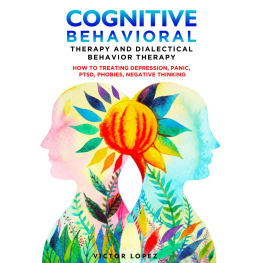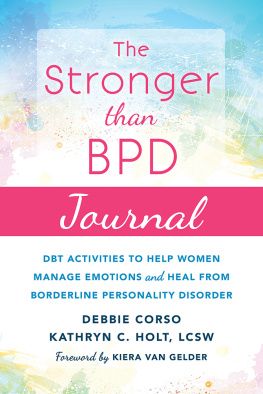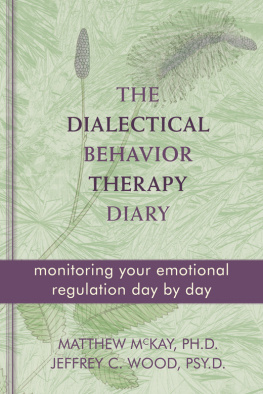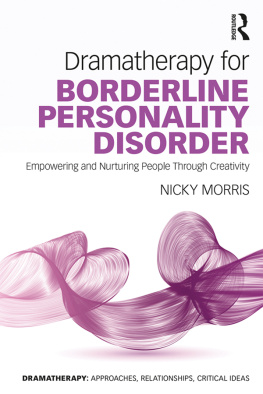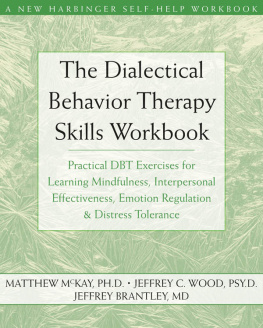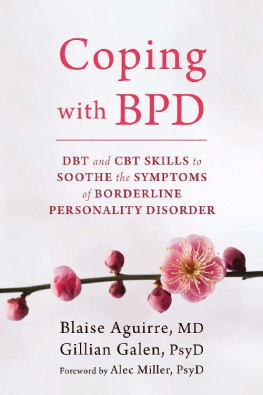
DBT Therapeutic Activity Ideas for Working with Teens
Skills and Exercises for Working with Clients with Borderline Personality Disorder, Depression, Anxiety, and Other Emotional Sensitivities
Carol Lozier

Jessica Kingsley Publishers
London and Philadelphia
Contents
Introduction
Adolescent mental health is a common concern in our society. Just reflecting on the names Columbine and Sandy Hook bring clear memories of devastation, loss, and of adolescents who suffered with emotional instability. Given the vulnerability of adolescents in todays world, it is our responsibility to teach young people the skills that they are missing due to mental health issues, and to any level of trauma they have endured.
In my practice as a therapist, I have specialized in treating those with trauma and, in particular, those who are adopted and foster children and teens. Initially, in my career, I focused on learning therapeutic modalities to heal the deep wounds of past trauma and loss. As I witnessed my clients healing from past traumas, I saw a reduction in their triggers, but noticed that they still struggled with unhealthy life skills, including hurtful coping skills: alcohol, drugs, self-cutting, self-harm, inordinate time asleep, excessive time on video games; emotional overreactions such as hitting, swearing, slamming doors, and refusing to comply with adult requests; and difficulty in getting along with others, for example in making and maintaining long-term relationships.
I began to search for another type of therapy to teach my clients these life skills, and found Dialectical Behavior Therapy (DBT). In my quest to learn DBT, I pursued online training from Dr Marsha M. Linehans site, Behavioral Tech, and have been participating in a biweekly consultation group. In learning DBT, I quickly concluded that full healing for my clients meant that there needed to be a marriage between healing past trauma and addressing current behavior deficits. The addition of DBT skills in my practice gives me hope and the belief that teens can have a healthy and joy-filled life, and they have to learn new skills to accomplish these goals.
The Adolescent
Adolescence, ages 13 through 19, is an exciting and trying time as teens transition from childhood to adulthood. In this stage, teens face the developmental tasks and issues of self-identity and independence.
In self-identity, teens are discovering their own values, beliefs, and occupational and personal goals. Teens are trying to find out who they are as young adults, and what is important to them. They are discovering new interests and hobbies, possible occupations in adulthood, a changing relationship with family, and social relationships and dating.
Adolescents are also becoming independent, and separating from the family in which they were raised; this may be a birth family, foster family, adoptive family, or even a facility. This is a challenging time as teens negotiate accepting and managing greater levels of responsibility. At times, the teens may push for more independence than they, or their family, are ready for them to have.
DBT Skills Trainers
DBT skills are taught by skill trainers and, often in a group, there is a leader and a co-leader. Skills trainers need to know and use DBT skills in their daily life; the required level of training differs according to the population they serve. If the adolescent has any mental health disorder, they will need to learn DBT from a mental health practitioner, such as a social worker, psychologist, marriage and family counselor, or psychiatric nurse. Teens without any history of current mental health disorder can learn skills from anyone who is trained and practicing DBT, such as a parent, teacher, youth pastor, or other family members.
Certainly, skills trainers need to know and use DBT in their daily life. In addition, it is most important for a trainer to have a respectful and caring interaction and attitude with the teen. Trainers need to create a validating and nurturing environment for them. Teens need to feel heard and understood; and to know that you, as the adult, are walking alongside them in their learning process.
Introducing DBT to Teens and Families
As with any new class or skill acquisition, teens and their families may initially be guarded to the idea. Therefore, introducing DBT to teens and families is crucial to gaining their compliance. Trainers can use the following statements as they dialogue with parents to express DBTs ability to improve a teens life:
DBT is a skills-based program where teens learn practical coping skills to improve their ability to focus their attention, manage feelings, deal with life stresses, and get along better with others. DBT has four groups of skills, and within each group there are numerous hands-on tools for teens to learn and use, creating a life in balance. DBT skills are a valuable toolkit for teens to have with them and use in any setting.
The Activity Book
The activity book does not go into vast detail on how to use DBT skills or manage a DBT skills group, rather it is meant to be a supplement to comprehensive DBT skills books or programs. The activity book offers fun and unique DBT skills handouts and worksheets for skills trainers to engage adolescents into a DBT practice.
Readers can gain more in-depth knowledge about DBT skills and DBT skills training at Behavioral Tech (for details, see the References), and in the following books: DBT Skills Training Handouts and Worksheets (Linehan, 2015a), DBT Skills Training Manual (Linehan, 2015b), DBT Skills in Schools (Mazza et al ., 2016), and DBT Skills Manual for Adolescents (Rathus and Miller, 2015).
All the handouts and worksheets in the activity book are based on DBT skills created by Marsha Linehan (2015a and 2015b), unless otherwise noted. A few handouts or worksheets are adapted from information from Dr James J. Mazza et al . (2016), and Dr Cathy Moonshine (2008).
The DBT skills handouts and worksheets are divided into four parts, following the four modules of DBT: Mindfulness, Distress Tolerance, Emotion Regulation, and Interpersonal Effectiveness. While the handouts and worksheets have been created for teens, they can be adapted or used with children and adults, too. Handouts and worksheets can be used individually or in group settings. They can be a stand-alone activity or incorporated into a traditional, weekly DBT skills group.
To begin with, each chapter will briefly describe the DBT skill. Typically, handouts will explain the skill while worksheets will individualize and offer practice in using the skill. Remember, for further details about each skill, refer to the skills books mentioned above and later again in the References.
Following the skill description, each chapter has directions on how to use the handout and worksheet; a completed example of the worksheet will precede the blank form. The blank worksheet will be given to your teen to fill out according to their individual ideas and understanding of the DBT skill. If the blank worksheet does not have enough space to write on, encourage the teen to use the back page of the worksheet to complete their answer. The handouts and worksheets can be photocopied and downloaded from www.jkp.com/voucher using the code t5ZKXPq6.
In the process of learning new information, everyone tends to have a mixture of learning styles: auditory, visual, and kinesthetic (hands-on learning). Many of your teens will have a primary learning style, and some may have a secondary style as well. I have incorporated images on the handouts and worksheets in order to further reach visual learners. This includes creative fonts, the typical DBT acronyms, and fun images. Along with the visual help, I encourage you to find ways to add auditory support through discussing the worksheets, and suggesting that teens read the worksheets silently to themselves or aloud within the group. Where possible, incorporate kinesthetic learning through role plays or body movement.
Next page

